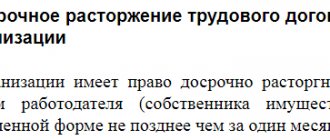Types of labor disputes and the procedure for their resolution
Lawyers classify labor disputes and the procedure for resolving them differently. However, most often we have to talk about ITS and CTS: individual or collective labor disputes. In the first case, the conflict arises between one employee and the employer(s). If disagreements affect several workers at once, the conflict is considered collective.
Not every dispute or quarrel with a boss is a labor dispute from a legal point of view. In order for a problem to receive ITS status, a superior or subordinate must report it to a special commission or court. The subject of such a conflict can be different:
- violation of labor and safety legislation, various regulations;
- financial issues related to wages, payment of vacation pay, sick leave, compensation;
- refusal to hire or conclude a contract, violation of the law during an interview or hiring;
- any disagreements that may arise between the employer and the former subordinate.
You can read more about the subjects of individual conflicts in the Labor Code of the Russian Federation. This is the main document covering all aspects of the relationship between employees and employers. However, this is not the only legal act regulating labor issues, and the correct interpretation of articles and provisions often requires competent legal advice.
Collective disputes are disagreements between several employees and management. Let us remember that the conflict should concern exclusively issues of labor and its payment, but not personal disagreements, which can also arise within the team.
Lawyers often have to deal with such a violation as failure to comply with a collective agreement or refusal of management to take into account the elected representative body of employees (subordinates have every right to create such a body to influence the drafting of local regulations). In short, the main difference between individual and collective conflicts is the number of parties they affect. However, conflicts can be classified according to other criteria.
Where labor disputes between employer and employee are considered
All executive authorities at the enterprise, which are created in the event of a collective dispute, are created on a temporary basis, and are released from their main work for the duration of the consideration of the collective dispute. Individual disputes are considered either by labor commissions, or labor inspectorates, or directly in court. An employee has the right to write a complaint to the labor commission or to the court within 3 months from the date of violation of his labor rights by the employer. Where labor disputes are considered The general procedure applies to most disputes that arise and involves an initial appeal to the CCC, and if it is impossible to resolve the issue with the help of the CCC, an appeal of the commission’s decision in court. However, there are a number of aspects of labor relations, disputes regarding which are carried out exclusively in court, without recourse to the commission.
We recommend reading: Terms of payment of savings under the Sberbank corporate pension program agreement
All labor disputes are divided into disputes from legal relations: 1) labor (their absolute majority); 2) for employment (for example, a disabled person who was not hired by reservation or another person with whom the employer is obliged to conclude an employment contract); 3) on supervision and control of compliance with labor legislation and labor protection rules; 4) on training and advanced training of workers in production; 5) for compensation of material damage by an employee to an enterprise; 6) compensation by the employer for damages to the employee in connection with damage to his health at work or violation of his right to work; 7) trade union body with the employer on issues of labor, everyday life, culture; collective of workers with the employer; 9) social-partner legal relations at four higher levels. Going to court.
2) for employment (for example, a disabled person who was not hired by reservation or another person with whom the employer is obliged to conclude an employment contract); 3) on supervision and control of compliance with labor legislation and labor protection rules; 4) on training and advanced training of workers in production; 5) for compensation of material damage by an employee to an enterprise; 6) compensation by the employer for damages to the employee in connection with damage to his health at work or violation of his right to work; 7) trade union body with the employer on issues of labor, everyday life, culture; collective of workers with the employer; 9) social-partner legal relations at four higher levels. Going to court.
Types of disputes according to the criterion of legal relations
The nature of conflicts can be considered based on the legal relations from which they arise. Thus, conflicts arising as a result of disruption of working relationships are distinguished. In this case, the subject of the dispute may be unpaid wages, illegal (in the opinion of one of the parties) dismissal, failure to register a work book, etc.
However, there are also labor disputes arising from violations of labor relations. These may be conflicts caused by the organization and management of work processes, the way a certain employer hires employees and formalizes them. This category also includes disputes caused by violation of partnership relations, attempts to interfere with the work of trade unions, disputes over professional training and advanced training, financial liability, supervision and control. When it comes to violations of mandatory social insurance norms, this is another problem in this category.
The procedure for resolving labor disputes in court or pre-trial directly depends on the causes of the conflict, its subject, nature, number of participants and other features.
Subject of collective labor dispute
Definition 2
A collective labor dispute is a labor dispute in which one of the parties is always a single group of workers.
Workers can be united organizationally (membership in a trade union, employees of the same organization, etc.), or have common professional and labor interests (for example, a labor dispute, one of the parties to which are medical workers). Second-party employers may also be represented collectively.
The subject of a collective dispute must meet two mandatory criteria:
Need advice from a teacher in this subject area? Ask a question to the teacher and get an answer in 15 minutes! Ask a Question
- one of its parties are workers united in a labor collective;
- is aimed at protecting labor standards and working conditions established by the collective agreement.
In order for a dispute to be recognized as a collective labor dispute, both features characterizing its subject must be present.
Disagreements between employees and the employer, which constitute the subject of a collective labor dispute, may arise when socio-economic working conditions are established or changed in an organization, which include:
- labor standards and piece rates;
- system and amount of remuneration;
- duration of working hours and rest time;
- provision of benefits associated with special or difficult working conditions;
- internal labor regulations and the like.
Nature and subject of the dispute
When lawyers talk about the nature of the conflict, they mean whether we are talking about the application of labor legislation or changes, establishing working conditions.
When employers block the work of trade unions and interfere with the voluntary organization of employees, we are dealing with the nature of the dispute with the application of legal norms. If management cannot ensure compliance with sanitary standards in the workplace, this is also a matter of enforcement. But if conditions do not allow the work to be done effectively, the nature of the conflict affects the establishment of working conditions.
Finally, the subject of the conflict can also be different. As a rule, lawyers deal with disputes about the recognition of a right violated by another party, or conflicts over the award of payments, compensation for harm and damages.
Methods for resolving labor disputes
There are two methods for resolving work conflicts: through the Labor Dispute Commission (CLC) or through the court. As a rule, employees first contact the commission, and if they have a competent lawyer on their side, disagreements can be resolved at this stage. But if the commission’s decision does not suit one of the parties, it has the right to appeal it in court.
However, the procedure for resolving labor disputes in court allows you to do without the CCC. An employee or manager has every right to immediately turn to the judicial authorities by filing a claim. A preliminary examination of the case by the commission is not at all necessary.
Separately, it is worth mentioning the special procedure for considering conflicts when other bodies are involved. The need for a special procedure for resolving a dispute arises when the parties to it are judges, prosecutors, investigators and other specialists directly related to justice.
Where is the Dispute between the Employee and the Employer Considered?
5All conditions of the collective agreement are divided into normative ones -
containing mandatory rules of conduct designed for an indefinite number of people (all employees of the organization) and an unlimited number of cases of application;
obligatory -
containing specific obligations of the parties, which are repaid by their fulfillment, and
informational -
reproducing the provisions of the law.
An employee can apply for a certificate within one month from the date of the decision of the labor dispute commission. If an employee misses the specified period for valid reasons, the labor dispute commission may restore this period. The certificate is not issued if the employee or employer applied within the prescribed period to transfer the labor dispute to the court.
We recommend reading: Purchasing a plot of land from the owner: procedure
Procedure for resolving individual labor disputes: brief description
How the ITS review should proceed is described in detail by the Labor Code in Chapter 60. As we have already mentioned, any conflicts can be resolved in two ways: pre-trial and judicial.
The pre-trial procedure assumes that the party who believes that its rights are being violated will send a written complaint to the labor commission. The law limits the period when you can file your claims: this is 3 months from the moment a person learns about a violation of his own rights. Accordingly, it is impossible to complain a year after the conflict occurred.
However, ITS arise even with an employee who has already been fired or has not yet been hired. Such conflicts can also be resolved pre-trial. Moreover, the commission has only 10 days from the date of filing the complaint to do this. Lawyers warn those who want to file a complaint: make sure that your application is registered, otherwise the complaint has no legal force.
The commission is formed from representatives of the employer and employees. Hearings are held outside working hours and with the obligatory presence of the applicant. The elected secretary of the meeting keeps minutes, and a decision is made based on the results of the meeting. Both sides of the conflict receive a copy of it within 3 days. The decision is binding, and if it suits both parties, the conflict can be considered settled.
Either party may appeal the decision within 10 days from the date of receipt. When this period expires, it is necessary to put the commission’s decision into effect within 3 days. In addition, if the commission does not consider the appeal in time, the parties may go to court. However, from the very beginning, the employee or employer can draw up a claim and file it in court. But keep in mind that it is important to collect evidence to support your position.
Procedure for consideration of collective disputes
Until 2006, issues of collective labor disputes were regulated by a separate federal law. However, it has lost force, and now one should focus on the Labor Code.
If a conflict arises between employers and several employees, the course of action differs from the ITS decision. The conflict in such a situation is dealt with by:
- intermediaries;
- conciliation commission;
- labor arbitration.
Employees should formulate their grievances in writing and file a complaint. It may affect working conditions and pay, changes to the collective agreement, local acts. First, the complaint is sent to the employer. After this, within two days, a conciliation commission is formed, which must consider the conflict.
As in the case of the labor dispute commission, this body should include representatives of both sides in equal proportions. The commission carefully considers the dispute within 3 working days.
One of the parties may avoid reconciliation. As a rule, this is the employer, who may even interfere with the work of the commission. Then the case is transferred to labor arbitration. This body is formed from representatives of government bodies that are involved in the settlement of labor disputes, as well as representatives of the organization. This body differs from the arbitration court in that it is temporary. As soon as the conflict is resolved, the arbitration will be dissolved. Based on the results of the arbitration meeting, the decision must be formalized in writing. Its implementation is mandatory for all parties to the conflict. But if at this stage the dispute is not resolved, and the parties are dissatisfied with the conclusion of the commission, you can resort to extreme measures provided for by the Labor Code. This is a strike. The procedure for conducting it, the responsibility of the parties and other issues are also regulated by law.





